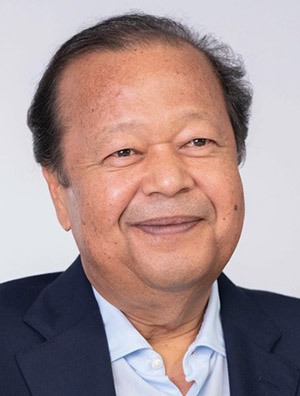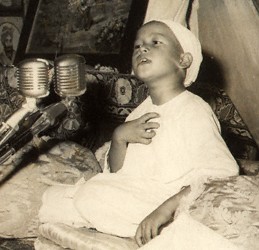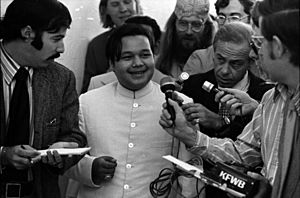Prem Rawat facts for kids
Prem Pal Singh Rawat, born on December 10, 1957, is a speaker and author from India. He was once known as Maharaji. He teaches a special meditation practice called 'Knowledge'. His work also focuses on peace education. This education helps people find inner strength, make good choices, feel thankful, and have hope.
Prem Rawat is the youngest son of Hans Ram Singh Rawat, an Indian spiritual teacher. His father started a group called Divine Light Mission (DLM). When his father passed away, eight-year-old Prem Rawat took on his role. At 13, he traveled to Western countries like the United States. Many young people became interested in his message. The group grew very quickly. Some news reporters were surprised by his young age. He was also criticized for his simple talks and for living a very comfortable life.
When Prem Rawat was 16, he married a woman who was not Indian. This caused problems with his mother. The Indian part of the DLM, controlled by his mother, separated from the DLM in other countries. At that time, the DLM was active in 55 countries. In the early 1980s, he stopped using religious words in his speeches. He also closed the special centers called ashrams. The DLM changed its name to Elan Vital. Since then, Prem Rawat has traveled a lot. He speaks about peace to many people around the world. He has received awards for his work and message of peace.
In 2001, he started The Prem Rawat Foundation (TPRF). This foundation supports his work and helps people in need. Its Peace Education Program is used in prisons and other groups worldwide.
Contents
Early Life and Beginnings (1957-1970)
Prem Pāl Singh Rawat was born in Haridwar, Uttarakhand, India. This was on December 10, 1957. He was the youngest of four sons. His father was a spiritual teacher named Hans Rām Singh Rawat. His mother was Jagat Janani Mata Shri Rajeshwari Devi. Prem Rawat went to elementary school in Dehra Dun.
At age four, he started speaking at his father's meetings. When he was six, his father taught him the 'Knowledge' meditation techniques. His father died in 1966. During the mourning period, his mother and other leaders discussed who would lead next. Before anyone was chosen, Prem Rawat spoke to the crowd. He reminded them that their teacher was still with them. After this, his mother, brother, and other leaders accepted him as their new teacher. They bowed to him and received his blessing.
Prem Rawat was known as Sant Ji before. Now he was called "Guru Maharaj Ji." People also called him "Balyogeshwar," meaning "born saint," because he was so young and wise. From then on, Prem Rawat spent weekends and school holidays traveling. He spoke about 'Knowledge' and inner peace. Because he was so young, his family helped manage the DLM.
In the 1960s, Westerners in India met DLM members. Some became followers. British followers invited him to visit the West. In 1969, he sent an Indian student to London. In 1970, many of his new Western followers flew to India to meet him. They were in Delhi when he gave a speech called the "Peace Bomb." He was only twelve years old. This speech marked the start of his international work.
Traveling the World (1971–1975)
In 1971, Prem Rawat traveled to the West. His first speech in the West was in June 1971 at Glastonbury Fayre. He then visited Los Angeles, New York, Washington, Canada, and South Africa. When he arrived in the United States, some people made fun of him. They thought he was too young to be a spiritual leader. But many young adults were very interested. They wanted to experience what he called a direct connection to God. Many people liked the joy and peace shown by his followers.
One person said that Prem Rawat "played the whole time he was there." He played with squirt guns and took pictures. People felt a lot of love between him and his followers. New members eagerly shared the message that the 13-year-old Prem Rawat could help people find God. He returned to India later that year with 300 Westerners. They stayed in the group's centers.
Prem Rawat started flying lessons when he was 13. He began jet training at age 15. In 1972, two small planes were bought for him to use. He traveled almost all the time. He had homes in the United Kingdom, the United States, India, and Australia.
In 1972, a festival called Hans Jayanti celebrated his father's birthday. Over 500,000 people attended. Six large planes were rented by American followers. They paid extra so South Americans could fly to India for free. Other countries also helped people with less money attend.
A reporter attended an event in Boston in August 1973. About 9,000 people came. The reporter wrote that Prem Rawat seemed humble and human. He seemed to try to make his followers' claims of his special status less strong. People who studied groups like his said that from the start, Prem Rawat asked followers to let go of ideas that might stop them from fully experiencing 'Knowledge'.
Followers focused on "love, peace, and happiness" in their lives. But the public often did not understand them. One person said that when he was 22, he found Prem Rawat's message simple and not well-spoken. But his friends spoke about it with great praise.
In August 1973, Prem Rawat was in Detroit. A journalist threw a shaving cream pie in his face. Prem Rawat said he did not want the attacker arrested or hurt. But the attacker was hurt a few days later. When local members heard, they told Prem Rawat. He asked for a full investigation. Two followers were identified as the attackers. The police were told right away.
Prem Rawat's public relations efforts were very strong. One journalist wrote that thousands of people followed him. Posters of his face were on walls in many cities. Reporters and TV cameras covered his public appearances. His large events attracted hundreds of thousands of followers.
A tour of US cities was cut short in September 1973. Prem Rawat was in the hospital with a stomach problem. His doctor said his body was tired from constant travel. It showed the stress of a busy adult.
The Hans Jayanti festival in 1973 was called "Millennium '73". It was held in the Houston Astrodome. News releases said the event would start "a thousand years of peace." The main organizers expected 100,000 or more people. About 20,000 people attended. National TV news did not cover it. But print media covered it a lot. It was also shown in a documentary. The followers were described as "cheerful, friendly, and calm." For the 400 parents who attended, Prem Rawat was someone who helped their children. Some reporters found his ideas "confused." The event was called the "youth culture event of the year."
The event did not meet expectations. It caused problems for the Divine Light Mission. It left them with a lot of debt. This forced changes within the group. By 1976, the DLM had reduced the debt. The debt was partly due to poor management by his family. It was also because fewer people attended than expected.
Because Prem Rawat was so young, his mother and eldest brother managed the DLM. When Prem Rawat turned sixteen, he wanted to guide the group more. This meant he had to take control from his mother. In December 1973, Prem Rawat took charge of the DLM in the US. His mother and brother went back to India.
By the end of 1973, the DLM was active in 55 countries. Tens of thousands of people had joined. Hundreds of centers and many ashrams were formed. 1973 was called the "peak of the Mission's success."
Rawat's comfortable lifestyle caused some discussion in the early 1970s. Some news reports said he "lived more like a king." Critics said his lifestyle was paid for by followers' donations. They said the group seemed to exist only to support his "comfortable life." Supporters said there was no problem with having both worldly and spiritual wealth. They said Rawat did not tell anyone to "give up material things." He said it was our strong attachment to them that was wrong. News reports listed expensive cars, some of them gifts. Rawat said, "I have something far more precious to give them than money and material things—I give peace." A spokesperson said, "Maharaj Ji's luxuries are gifts from a Western culture." Some followers said he did not want the gifts. But people gave them out of love for him.
In May 1974, a judge allowed Prem Rawat to marry without his parents' permission. He married Marolyn Johnson, a 24-year-old follower. The wedding was in Colorado. Prem Rawat's mother was not invited.
Prem Rawat's marriage to a non-Indian ended his relationship with his mother. She kept control of the Indian DLM. She named his brother Satpal as its leader. His mother said she was removing Prem Rawat as the Perfect Master. She said it was because of his "unspiritual" lifestyle and not respecting her wishes. Rawat kept the support of his Western followers. Most of the Indian teachers either went back to India or were dismissed. Prem Rawat became wealthy from gifts from his Western followers. He lived like an American millionaire. He had a home for his wife, his brother, and his sister-in-law. He paid for travel for his close helpers who went with him on his trips. By early 1974, the number of full-time DLM staff grew from six to over one thousand.
In November 1974, Prem Rawat moved to a 4-acre property in Malibu, California. He wanted more privacy for his family and helpers. The DLM bought the property for $400,000. It became the DLM's West Coast office. There was a small issue about a helipad on the property. This was solved by adding water storage for the fire department. They also limited the number of flights.
Changes and Growth (1976–2000)
By 1976, most followers saw Prem Rawat mainly as a spiritual teacher and guide. In January 1976, Prem Rawat told them to leave the ashrams. He also told them to stop using Indian customs and words. He said the organization had come between him and his followers. He gave some decision-making power to local groups. But he remained the main authority on spiritual matters. The staff at the Denver office was reduced. He said the way the group was managed was "only for show and totally unnecessary."
His appearance on December 20, 1976, in Atlantic City, New Jersey, was important. He wore a traditional Indian costume for the first time since 1975. This showed a return to some Indian influences. In 1977, many people went back to living in ashrams. There was a shift back towards rituals and spiritual beliefs. In 1977, Rawat became a US citizen.
In October 1978, a wildfire burned the hills around Rawat's Malibu home. His family and the DLM office then moved to Miami Beach, Florida. The family, which now had four children, returned to Malibu in 1984.
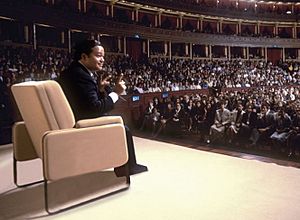
During the 1970s and 1980s, the group received a lot of negative attention. In January 1979, a newspaper reported that Rawat kept his followers in Malibu. This was despite growing distrust of such groups. Some former leaders said that money was increasingly used for Prem Rawat's personal needs. They also said the group's goals became impossible to reach. These claims did not get much support. They did not stop the group's progress.
In 1980, Rawat removed all "religious" parts of the group. He said he now wanted "no movement whatsoever." The Hindu words and religious stories in his teachings changed. They focused more on the meditation techniques. He was once called "Perfect Master." Rawat stopped using this "almost divine status." But he still said he was a master. In 1983, the Divine Light Mission was renamed Elan Vital. Rawat closed the last Western ashrams. This marked the end of using Indian methods for international goals.
During this time, Rawat traveled a lot. In one two-year period, he spoke at over 100 events. These were in 37 cities around the world. These included New York, London, Paris, and Tokyo.
In 1990, there were said to be 1.2 million followers worldwide. 50,000 of them were in the United States. In 1999, regular satellite broadcasts began. These went to North America and other countries.
Recent Work (2001 – present)
In 2001, Prem Rawat started The Prem Rawat Foundation (TPRF). This is a public charity. It supports his message and helps people around the world. TPRF has given food, water, and medical help to areas affected by war and poverty.
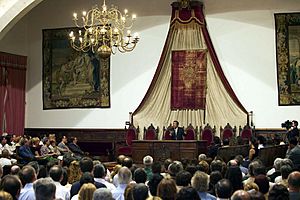
In 2006, a professor noted that Elan Vital explained how Rawat reached over 80 countries. He used a leased private jet, which he flew himself. He flew about a quarter million miles each year.
A book about Rawat, Peace is Possible, was published in 2006. In 2007, Rawat started the Peace Education Program for people in prison. As of 2012, it was in 25 prisons in 10 countries. A professor of criminal justice said that "constructive changes in behavior" were seen among participants.
In 2006, Prem Rawat received the honorary title of Ambassador of Peace in Brazil. In 2009, he was made Ambassador of Peace for a region in Italy. In 2010, he spoke at a peace conference in Brussels. This was at the invitation of a European Parliament leader.
In 2011, he spoke again at the Brussels conference. He was named ambassador of the Brussels Declaration “Pledge to Peace.” This pledge was inspired by freedom, equality, and working together. It encourages governments and groups to create peace projects.
In 2012, in Malaysia, Prem Rawat received a Lifetime Achievement Award. This was for his work in promoting global peace.
In 2016, Prem Rawat gave the main speech at an event in London. It was hosted by TPRF and another foundation. Government officials and leaders met to talk about peace education. They also discussed ways to avoid violence and improve prisons.
In March 2021, the Italian Ministry of Justice signed an agreement. This was to use the Peace Education Program for helping people in prison. In April 2021, a similar agreement was signed with the South African government. This was to use the program in their correctional centers.
On June 17, 2022, Prem Rawat received the first “Key of Avalon” award. This was from the Council of Glastonbury, United Kingdom. It recognized his fifty years of working for peace and helping humanity.
Rawat is mentioned in the Guinness Book of World Records. The largest audience for a book reading by one author was 114,704 people. This was achieved by Prem Rawat in Lucknow, India, on April 2, 2023. He read from his book “Hear Yourself” in Hindi. The largest attendance at a lecture was 375,603 people. This was achieved by Prem Rawat in Gaya, India, on November 26, 2023.
His Teachings
The main idea of Prem Rawat's teaching is that people can find peace and joy inside themselves. He says this can be done by looking within. He does not focus on strict rules or beliefs. Instead, he highlights a direct experience of peace. He says this is possible through the meditation techniques he teaches.
Some experts say his teachings started from an Indian tradition. This tradition says that true religion is about loving God, who lives in your heart. Another expert says his teachings are similar but different. He adds that Rawat does not think his family history is important. He does not believe his authority comes from a long tradition.
Rawat has been criticized for his public talks. Some say they do not have deep intellectual ideas.
The 'Knowledge' Techniques
Prem Rawat says that light, love, wisdom, and clarity are inside everyone. He teaches meditation techniques to help people find these things. These techniques are called 'Knowledge'. In his public talks, he uses quotes from Hindu, Muslim, and Christian holy books. But he gets his ideas and guidance from his own inner experience.
Before learning 'Knowledge', Rawat asks people to promise to try it fairly. He also asks them to stay in touch with him. He asks them not to tell others the techniques. Instead, he wants others to prepare to learn them for themselves.
People who practice 'Knowledge' say it is a very personal experience. It does not have a social structure, special ceremonies, or strict rules. According to one expert, Prem Rawat says he offers practical ways to find inner peace. Anyone can use these ways. This expert writes that Rawat first wanted to bring world peace. But now he focuses on helping individuals, not society as a whole.
Another expert describes 'Knowledge' as based on understanding yourself. It is about an inner self that is the same as the divine.
Organizations Supporting His Work
Rawat took over the first organization, Divine Light Mission, from his father. Later, he moved away from Indian traditions. He then started Elan Vital and Words of Peace International. These groups are not tied to Indian culture or beliefs. The Prem Rawat Foundation (TPRF), started in 2001, also focuses on helping people.
Divine Light Mission
The Divine Light Mission (DLM) was started in 1960 by Hans Rawat. This was for his followers in northern India. In the 1970s, the DLM became well-known in Western countries. This was under the leadership of his youngest son, Prem Rawat. Some experts noted the influence of Indian holy books and traditions. But the Western group was often seen as a new religious movement or a spiritual group. DLM officials said the group was a church, not a religion.
Elan Vital and Words of Peace International
The DLM was closed when Prem Rawat decided to move away from Indian culture and religion. He wanted his teachings to be free of culture, beliefs, and lifestyles. The DLM in the United States changed its name to Elan Vital in 1983. Elan Vital became the name for several groups that supported Rawat's work. These groups in different countries raised money. They also organized his speaking events and broadcast his talks. Today, Elan Vital is no longer linked to its original Hindu or Sikh religious background. Elan Vital, Inc. in the U.S. is a non-profit group. It has been called a "church" for tax reasons. Its purpose in 2005 was to do "religious, charitable, and educational activities." The Elan Vital website says that Elan Vital stopped working in 2010. New groups like Words of Peace International, Inc. took its place.
The Prem Rawat Foundation
In 2001, Prem Rawat started The Prem Rawat Foundation (TPRF). This is a public charity. It produces and shares materials that promote his message. It also funds humanitarian efforts around the world. TPRF has given food, water, and medical help to areas in need.
The Peace Education Program (PEP) was started by TPRF. It is an educational program that uses media. It helps people explore the idea of personal peace. It also helps them find inner resources. These are tools for living, like inner strength, choice, appreciation, and hope. The program has been successful in some schools. By 2012, it was also used in 28 prisons in 10 countries. These included the United States, South Africa, and Australia. This program helps people in prison learn about themselves. It gives them hope for a better life.
See also
 In Spanish: Prem Rawat para niños
In Spanish: Prem Rawat para niños


